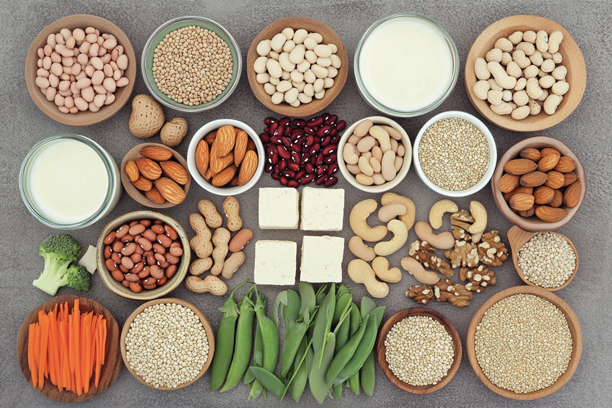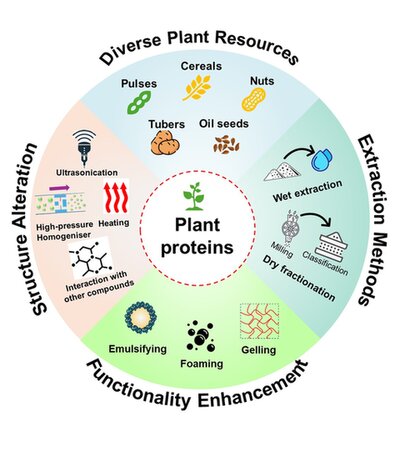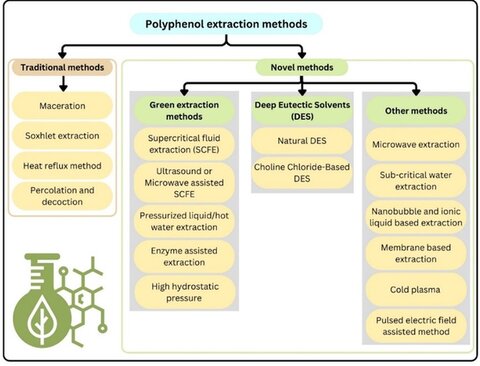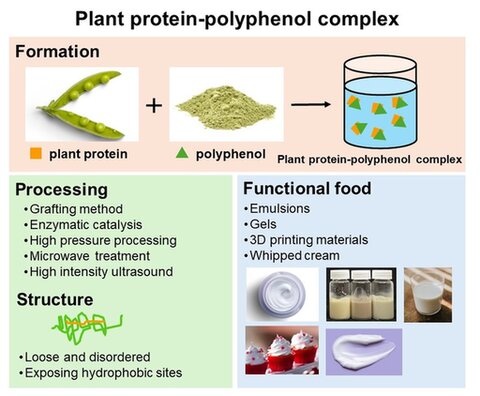KEYWORDS
Plant protein
Polyphenol
Protein modification
Food structure
Protein-polyphenol interaction
Holistic well-being
Abstract
Food proteins are primary macronutrients, while polyphenols are secondary metabolites in plants, known for their antioxidant properties and therapeutic effects. Interactions between plant protein and polyphenols occur naturally in many formulations, affecting their structure, functionality, and nutritional properties. Here, we discuss the structure and techno-functional properties of plant proteins and polyphenols, their interaction dynamics, and structure formation in food colloids. The incorporation of polyphenols has been shown to tune the physical, chemical, and functional properties of plant proteins, impacting the structure of plant-based foods. The combination between plant proteins and polyphenols shows promising as functional ingredients in plant-based foods.
Introduction
Over the past decade, the food industry has shifted towards plant proteins, driven by growing demand for sustainable and health-conscious alternatives to animal proteins. However, this transition, while promising, presented several technical challenges. These include issues related to solubility, digestibility, and flavour of plant proteins, which limit their broader applications. Furthermore, plant proteins generally exhibit poorer techno-functional properties, such as emulsifying, foaming, and gelling abilities, compared to animal proteins. Recent research suggests that the strategic incorporation of polyphenols, natural compounds known for their antioxidant and therapeutic benefits, can address these limitations. By forming protein-polyphenol complexes, the functional attributes of plant proteins can be significantly enhanced, paving the way for their use in innovative food products such as functional beverages, protein bars, and nutrient-encapsulated foods. This paper aims to investigate the effectiveness of plant protein-polyphenol complexes in improving the functionality of plant proteins, to advance their potential application in plant-based functional foods.

Plant protein
Plant proteins have attracted considerable attention due to their sustainability and health benefits in the past decade, and the global market is expected to reach USD 20.5 billion by 2029 (1). Plant protein bodies are mainly contained within the storage cells of plants, requiring the destruction of the cell walls for extraction purposes (2), which can be classified into four types: albumin, globulin, prolamin, and glutelin (3). Plant protein extraction commonly involves pulses (soy, pea, lupin, fava bean, chickpea), cereals (wheat, rice, oats), nuts (almond, peanut), tuber (potato), and oil seeds (flaxseed). Generally, extraction methods for plant proteins include wet extraction and dry fractionation. Traditional wet extraction (alkaline solubilisation and isoelectric precipitation) can obtain proteins with high purity, but the protein structure will be denatured due to the intensive chemical extraction process (4, 5). In comparison, mild wet extraction preserves the native protein structure and original protein functionality by avoiding harsh extraction processes like isoelectric precipitation, though the purity of the extracted protein is low (4). Other than wet extraction, dry fractionation is solvent-free and can retain the native state of the plant proteins to a large extent (5), while the protein from dry fractionation is mixed with non-protein impurities (>10%) such as starch, fibre, etc (5). The overview of plant protein development is shown in Figure 1. The techno-functional properties of plant proteins (emulsifying, foaming, and gelling capacities) are crucial for their uses in food systems. Some studies have suggested that the functionality of extracted plant proteins can be preserved in their native state (5), while others have pointed out that plant proteins with moderate structural alteration exhibit the potential to achieve better functionality (6). For example, native plant proteins with compact structures can be treated with heating (7), ultrasound (8) , and high-pressure processing (9) to induce partial unfolding and become more flexible, improving protein adsorption at the oil/water interface. Plant proteins can change their secondary structures and improve their usability in food systems by enzymatic treatment (10) or by forming non-covalent or covalent bonds with polysaccharides (11, 12) or polyphenols (13). New focus of plant protein research is more on protein functionality rather than purity. Pea protein concentrates with limited fractionation achieved higher gelling ability and stronger gelling strength than pea protein isolates with high purity due to the difference in the extraction process and the different amounts of sugars and ash content (14). Plant albumins, the side stream from plant globulin extraction, show an excellent foaming capacity, which allows albumins to upgrade from a side stream into valuable foaming agents in food products (4, 15). Moreover, the cooking water of chickpeas (aquafaba) containing albumin, polysaccharides and saponins is a good egg replacement (16). The focus of current plant protein research is to use practical methods to modify protein structure and to improve their functionality. The goal is to develop underutilised plant proteins with improved functionality in food products.

Figure 1. Overview of plant protein resources, extraction, modification, and functionality.
Polyphenol
Polyphenols include diverse phenolic structures derived from plant sources and are broadly divided into flavonoids (including anthocyanins, flavanols, flavanones, flavonols, and isoflavones) and non-flavonoids, such as phenolic acids, tannins, lignans, xanthones, and stilbenes (17). These compounds are abundant in a variety of plant-based foods and beverages, including fruits (citrus fruits and berries), nuts, vegetables (broccoli and onions), cocoa, pulses, cereals, tea, coffee, and wine. They play a vital role in human health by exerting a range of therapeutic effects including maintenance of cardiovascular health (18), reduced risks of stroke and myocardial infarction (19), and improvements in lipid profiles (20), blood pressure, and systemic inflammation (21). Dietary polyphenols are generally recognised for their antioxidant properties, supporting the reduction of oxidative damage to biological molecules like lipids, proteins, enzymes, carbohydrates, and DNA (22, 23). They perform by scavenging radicals or activating the body’s inherent cellular antioxidant system, thereby boosting defenses against oxidative stress or by impacting gene transcription related to antioxidant defense and various cellular processes via nutri-epigenomic mechanisms (17, 23).
Apart from their therapeutic effects, polyphenol-rich foods including soy products, cocoa, and green tea-based beverages provide a preservative effect by scavenging reactive species, inhibiting lipoxygenase, and acting as reducing agents for metmyoglobin on food. Polyphenols also exert antimicrobial effects by interacting with components of bacterial cell walls, inhibiting microbial enzymes, or interfering with protein regulation thereby controlling biofilm formation and bacterial growth (24, 25). This effect can be incorporated into food products via the addition of polyphenols as conjugates or as ternary mixtures (26, 27).
Compared to the traditional solvent extraction or maceration, advanced extraction technologies (Fig. 2) including supercritical fluid extraction, ultrasonic-assisted extraction, microwave-assisted extraction, high-hydrostatic pressure extraction (HHPE), and glycerol and citric acid-based deep eutectic solvents (DES), efficiently extract polyphenols from food wastes like hazelnuts, coffee, grapes, spinach, tomato peels, onion waste and orange residues, providing high yields and antioxidant activity (28, 29, 30). Additional methods include Hybrid Molecular Imprinted Membranes (HMIMs) synthesised with quercetin molecular imprinted polymer nanoparticles, adsorption, and membrane technologies using Amberlite resins or zeolites, followed by ultrafiltration, which is effective for recovering polyphenols from wastewater, such as blanch water from marzipan production, or lemon waste (31). Nonthermal extraction techniques like cold plasma, pulsed electric field, and pressurised liquid extraction offer promising alternatives to conventional methods, reducing the need for heat and solvents (32).
All the above-mentioned methods utilise non-toxic solvents, maintain moderate temperatures, achieve fast extraction times, and require low energy input to produce bioactive compounds from food wastes for use in the cosmetic, pharmaceutical, and food industries, paving the way for more potentially sustainable alternatives for extraction.

Figure 2. Polyphenol isolation techniques that are segregated by conventional and novel methods.
Incorporation of polyphenol with plant protein
The incorporation of polyphenols into food matrices typically improves the functional properties and quality of food products. The interactions between plant protein and polyphenols can offer improved functional properties of plant protein by modifying the protein structure (Fig. 3). With one or more hydroxyl groups in the aromatic systems, polyphenols interact with proteins to alter the structure and antioxidant capacity of the proteins (33). Covalent bonds formed between protein and polyphenol alter protein structure to a larger extent compared to non-covalent interaction, leading to a greater impact on their functional properties (e.g. emulsification, foaming properties). Methods to form covalent interactions, including alkaline reactions, free radical grafting, or enzymatic reactions, initially promote polyphenols to form semi-quinone radicals, which then rearrange to quinones, conducive to cross-link with proteins (C-N or C-S bond) (26). On the other hand, non-covalent interactions between protein and polyphenol, such as hydrogen bonding and hydrophobic interaction, are generally weaker and are potentially reversible (34). However, non-covalent interactions are considered important for the extension of the shelf life of food products by altering protein structure, being the latter more unfolded and less aggregated, providing antioxidant protection to protein and lipids, and positively affecting the sensory properties. For example, the incorporation of Tasmanian pepper leaf or berry successfully prevented lipid oxidation of pea protein-stabilised emulsions by improving the antioxidant activity of pea protein. Phenolic acids and flavonols in Tasmanian pepper leaf with lower molecular weights showed stronger non-covalent interactions with pea protein, leading to superior antioxidant activity compared to anthocyanins in Tasmanian pepper berry (35).
Given that plant proteins possess complex globular structures or a network formed by prolamin/glutelin, the processing strategies for plant protein-polyphenol interactions are critically distinct from those for animal proteins. For example, grafting methods and enzymatic catalysis are common techniques to promote animal protein-polyphenol interactions. In contrast, physical processing technologies such as high-pressure processing, microwave treatment, and high-intensity ultrasound treatment with high energy intensity have demonstrated effectiveness in inducing plant protein-polyphenol interactions while also modifying secondary/tertiary structures of proteins (26). In particular, high-intensity ultrasound treatment is of interest due to its ability to generate hydroxyl radicals, leading to the formation of covalent bonds between plant proteins and polyphenols (36).
When polyphenols are combined with proteins, the emulsifying and foaming abilities of plant proteins are generally reinforced with increasing polyphenol concentration (37). This phenomenon is due to the modification of the unordered structure of proteins by polyphenols that results in better adsorption at the oil/water or air/water interface, creating smaller oil droplets and/or air bubbles, leading to the improved stability of the emulsion and foam-based systems (26). However, adding excessive polyphenols can cause protein aggregation, leading to negative effects in emulsions and foams (38). On the other hand, the impact of polyphenols on the gelling ability of plant proteins remains to be fully understood. We know that polyphenols can modulate gel strength (39), promising for future studies.

Figure 3. The formation, processing, structure, and functional food application of plant protein-polyphenol complexes.
Potential for functional foods
Plant proteins could be an integral part in developing functional foods as natural emulsifiers, gelling, and film-forming agents. Plant protein has proven to be a viable solution to encapsulate lipophilic and hydrophilic bioactive ingredients for sustained and targeted release and protection (40). Enhancing the properties of plant proteins by incorporating polyphenols should be investigated further.
In the emulsion systems, the modification of plant protein with polyphenol resulted in smaller oil droplet and improved uniformity (26). The complexation of anthocyanins with soy protein in emulsions could improve the storage stability of emulsion by reducing creaming by 20% over 7 weeks of storage (41). The antioxidant capacity of anthocyanins has shown a reduction in the rate and extent of lipid oxidation, implying that its addition could increase the stability of a sensitive cargo. Plant protein-polyphenol complexes have also been used to create hydrogels and emulsion gels. The presence of polyphenols is seen to increase the physical interactions between protein molecules and protein-stabilised droplets, thus increasing the mechanical strength of the gel (42, 43). Shear-thinning properties were reported in a pea protein isolate-tannic acid-hyaluronic acid complex in high internal phase emulsion, rendering them suitable for creating custom designs in 3D-printing. Customisable plant protein-polyphenol gels allow manufacturers to create attractive functional food with highly detailed appearances that could be tailored for any demographic. The shelf life and bioaccessibility of protein-polyphenol functional food are highly competitive. The stability is enhanced by the dense three-dimensional networks in gel-based functional food, and the inherent antioxidant activity of polyphenols culminated in the increased bioaccessibility of encapsulated bioactive ingredients.
The benefits of polyphenol modification are not limited to enhancing the physical properties of plant protein products, as polyphenols may also act as active ingredients. Polyphenol supplementation has been shown to improve athlete recovery from muscle damage by minimising cell damage and post-exercise muscle inflammation, as well as supporting the growth of gut microbiota (44, 45). The multi-dimensional benefit that plant protein-polyphenol complexes introduce is promising in delivering more benefits while slimming the ingredients list.
Conclusion
The combination of plant protein and polyphenols holds enormous potential as functional food ingredients with improved emulsifying, foaming, and gelling ability of plant proteins. The fortified antioxidant activity of plant protein-polyphenol complexes has been shown to prevent lipid oxidation, slow down the deterioration of food products, and provide proven therapeutic effects. Improvements in sensorial and nutritional profiles are critical to stimulate their applications in plant-based foods, including as functional beverages, food gels, and 3D printing materials.
References and notes
- Markets Ma. Plant-based Protein Market by Source (Soy, Wheat, Pea, Canola Oats, Rice & Potato, Beans & Seeds, Fermented Protein), Type (Concentrates, Isolates, Textured), Form (Dry, Liquid), Nature (Conventional, organic), Application - Global Forecast to 2029 2024 [Available from: https://www.marketsandmarkets.com/Market-Reports/plant-based-protein-market-14715651.html.
- Kornet C, Venema P, Nijsse J, van der Linden E, van der Goot AJ, Meinders M. Yellow pea aqueous fractionation increases the specific volume fraction and viscosity of its dispersions. Food Hydrocoll. 2020;99:105332.
- Kim WJ, Yiu CCY, Wang Y, Zhou WB, Selomulya C. Toward Diverse Plant Proteins for Food Innovation. Adv Sci. 2024;11(38).
- Kornet R, Yang J, Venema P, van der Linden E, Sagis LMC. Optimizing pea protein fractionation to yield protein fractions with a high foaming and emulsifying capacity. Food Hydrocoll. 2022;126:107456.
- Assatory A, Vitelli M, Rajabzadeh AR, Legge RL. Dry fractionation methods for plant protein, starch and fiber enrichment: A review. Trends Food Sci Tech. 2019;86:340-51.
- Lao Y, Ye Q, Wang Y, Vongsvivut J, Selomulya C. Quantifying the effects of pre-roasting on structural and functional properties of yellow pea proteins. Food Res Int. 2023;172:113180.
- Peng WW, Kong XZ, Chen YM, Zhang CM, Yang YX, Hua YF. Effects of heat treatment on the emulsifying properties of pea proteins. Food Hydrocoll. 2016;52:301-10.
- Sha L, Koosis AO, Wang QL, True AD, Xiong YL. Interfacial dilatational and emulsifying properties of ultrasound-treated pea protein. Food Chem. 2021;350(January):129271.
- Zhou L, Zhang WA, Wang JY, Zhang RY, Zhang J. Comparison of oil-in-water emulsions prepared by ultrasound, high-pressure homogenization and high-speed homogenization. Ultrason Sonochem. 2022;82.
- Fang LY, Xiang H, Sun-Waterhouse D, Cui C, Lin JJ. Enhancing the usability of pea protein isolate in food applications through modifying its structural and sensory properties via deamidation by glutaminase. J Agr Food Chem. 2020;68(6):1691-7.
- Wijaya W, Patel AR, Setiowati AD, Van der Meeren P. Functional colloids from proteins and polysaccharides for food applications. Trends Food Sci Tech. 2017;68:56-69.
- Lao Y, Wang Y, Selomulya C. Exploring the oil-water interfacial behaviour of pea protein-guar gum/gellan gum mixtures relating to stability and in vitro protein digestion of model pea milk system. Int J Biol Macromol. 2024;282:136749.
- Zhou JY, Hopfer H, Kong LY. Odor-scavenging capabilities of pre-formed "empty" V-type starches for beany off-flavor compounds. Food Hydrocoll. 2024;147.
- Kornet R, Veenemans J, Venema P, van der Goot AJ, Meinders M, Sagis L, et al. Less is more: Limited fractionation yields stronger gels for pea proteins. Food Hydrocoll. 2021;112:106285.
- Yang J, Kornet R, Diedericks CF, Yang QHZ, Berton-Carabin CC, Nikiforidis CV, et al. Rethinking plant protein extraction: Albumin-from side stream to an excellent foaming ingredient. Food Struct. 2022;31:100254.
- Eren E, Icyer NC, Tatlisu NB, Kilicli M, Kaderoglu GH, Toker OS. A new trend among plant-based food ingredients in food processing technology: Aquafaba. Crit Rev Food Sci. 2021.
- Durazzo A, Lucarini M, Souto E, Cicala C, Caiazzo E, Izzo A, et al. Polyphenols: A concise overview on the chemistry, occurrence, and human health. Phytotherapy Research. 2019;33:2221-43.
- Behl T, Bungau S, Kumar K, Zengin G, Khan F, Kumar A, et al. Pleotropic Effects of Polyphenols in Cardiovascular System. Biomedicine & Pharmacotherapy. 2020;130:110714.
- Fraga CG, Croft KD, Kennedy DO, Tomás-Barberán FAJF, function. The effects of polyphenols and other bioactives on human health. 2019;10(2):514-28.
- Potì F, Santi D, Spaggiari G, Zimetti F, Zanotti IJIjoms. Polyphenol health effects on cardiovascular and neurodegenerative disorders: a review and meta-analysis. 2019;20(2):351.
- Williamson G. The role of polyphenols in modern nutrition. 2017;42(3):226-35.
- Rudrapal M, Khairnar S, Johra K, Abdulaziz Bin D, Ansari M, Alomary M, et al. Dietary Polyphenols and Their Role in Oxidative Stress-Induced Human Diseases: Insights Into Protective Effects, Antioxidant Potentials and Mechanism(s) of Action. Frontiers in Pharmacology. 2022;13.
- Ruskovska T, Maksimova V, Dragan M, Dragan M. Polyphenols in human nutrition: from the in vitro antioxidant capacity to the beneficial effects on cardiometabolic health and related inter-individual variability – an overview and perspective. British Journal of Nutrition. 2019;123:241-54.
- Hammad U, Yaseen H, Cristina S, Baldi A, Minno AD, Haroon K, et al. Natural Polyphenols for the Preservation of Meat and Dairy Products. Molecules. 2022;27.
- 25. Martinengo P, Arunachalam K, Chunlei S. Polyphenolic Antibacterials for Food Preservation: Review, Challenges, and Current Applications. Foods. 2021;10.
- 26. Kim W, Wang Y, Selomulya C. Emerging technologies to improve plant protein functionality with protein-polyphenol interactions. Trends in Food Science and Technology. 2024:104469.
- Naik RR, Ye Q, Wang Y, Selomulya C. Insights into multi-component digestion and antioxidant release from plant protein-seaweed-based Maillard conjugate-MRP systems. Future Foods. 2024;9:100380.
- Hongli C, Siyong Y, Zhiying X, Zhanming L, Juanjuan G, Zhongyang R, et al. Novel extraction methods and potential applications of polyphenols in fruit waste: a review. Journal of Food Measurement and Characterization. 2021;15:3250-61.
- Ojha KS, Aznar R, O'Donnell C, Tiwari BK. Ultrasound technology for the extraction of biologically active molecules from plant, animal and marine sources. TrAC Trends in Analytical Chemistry. 2020;122:115663.
- Antony A, Farid M. Effect of temperatures on polyphenols during extraction. Applied Sciences. 2022;12(4):2107.
- Mansour M, Abdel-shafy H, Mehaya F. Valorization of food solid waste by recovery of polyphenols using hybrid molecular imprinted membrane. Journal of Environmental Chemical Engineering. 2018.
- Ebrahimi P, Lante A. Environmentally Friendly Techniques for the Recovery of Polyphenols from Food By-Products and Their Impact on Polyphenol Oxidase: A Critical Review. Applied Sciences. 2022.
- Sun X, Sarteshnizi RA, Udenigwe CCJCOiFS. Recent advances in protein–polyphenol interactions focusing on structural properties related to antioxidant activities. 2022;45:100840.
- 34. Quan TH, Benjakul S, Sae-leaw T, Balange AK, Maqsood S. Protein–polyphenol conjugates: Antioxidant property, functionalities and their applications. Trends in Food Science & Technology. 2019;91:507-17.
- Kim W, Zia MB, Naik RR, Ho KKHY, Selomulya C. Effects of polyphenols from Tasmannia lanceolata on structural, emulsifying, and antioxidant properties of pea protein. Food Chem. 2025;464:141589.
- Guo Y, Wang M, Xing K, Pan M, Wang LJUS. Covalent binding of ultrasound-treated japonica rice bran protein to catechin: Structural and functional properties of the complex. 2023;93:106292.
- Günal-Köroğlu D, Lorenzo JM, Capanoglu E. Plant-Based Protein-Phenolic Interactions: Effect on different matrices and in vitro gastrointestinal digestion. Food Research International. 2023;173:113269.
- Yan X, Zeng Z, McClements DJ, Gong X, Yu P, Xia J, et al. A review of the structure, function, and application of plant-based protein–phenolic conjugates and complexes. 2023;22(2):1312-36.
- Chen D, Stone S, Ilavsky J, Campanella O. Effect of polyphenols on the rheology, microstructure and in vitro digestion of pea protein gels at various pH. Food Hydrocolloids. 2024;151:109827.
- Yiu CC, Liang SW, Mukhtar K, Kim W, Wang Y, Selomulya C. Food Emulsion Gels from Plant-Based Ingredients: Formulation, Processing, and Potential Applications. Gels. 2023;9(5).
- Ju M, Zhu G, Huang G, Shen X, Zhang Y, Jiang L, et al. A novel pickering emulsion produced using soy protein-anthocyanin complex nanoparticles. Food Hydrocolloids. 2020;99.
- Li Z, Zhang L, Shan Y, Zhao Y, Dai L, Wang Y, et al. Fabrication of high internal phase emulsions (HIPEs) using pea protein isolate-hyaluronic acid-tannic acid complexes: Application of curcumin-loaded HIPEs as edible inks for 3D food printing. Food Chem. 2024;460(Pt 1):140402.
- Liu X, Xie F, Zhou J, He J, Din Z-u, Cheng S, et al. High internal phase Pickering emulsion stabilized by zein-tannic acid-sodium alginate complexes: β-Carotene loading and 3D printing. Food Hydrocolloids. 2023;142.
- Bowtell J, Kelly V. Fruit-Derived Polyphenol Supplementation for Athlete Recovery and Performance. Sports Med. 2019;49(Suppl 1):3-23.
- Ma G, Chen Y. Polyphenol supplementation benefits human health via gut microbiota: A systematic review via meta-analysis. Journal of Functional Foods. 2020;66.



